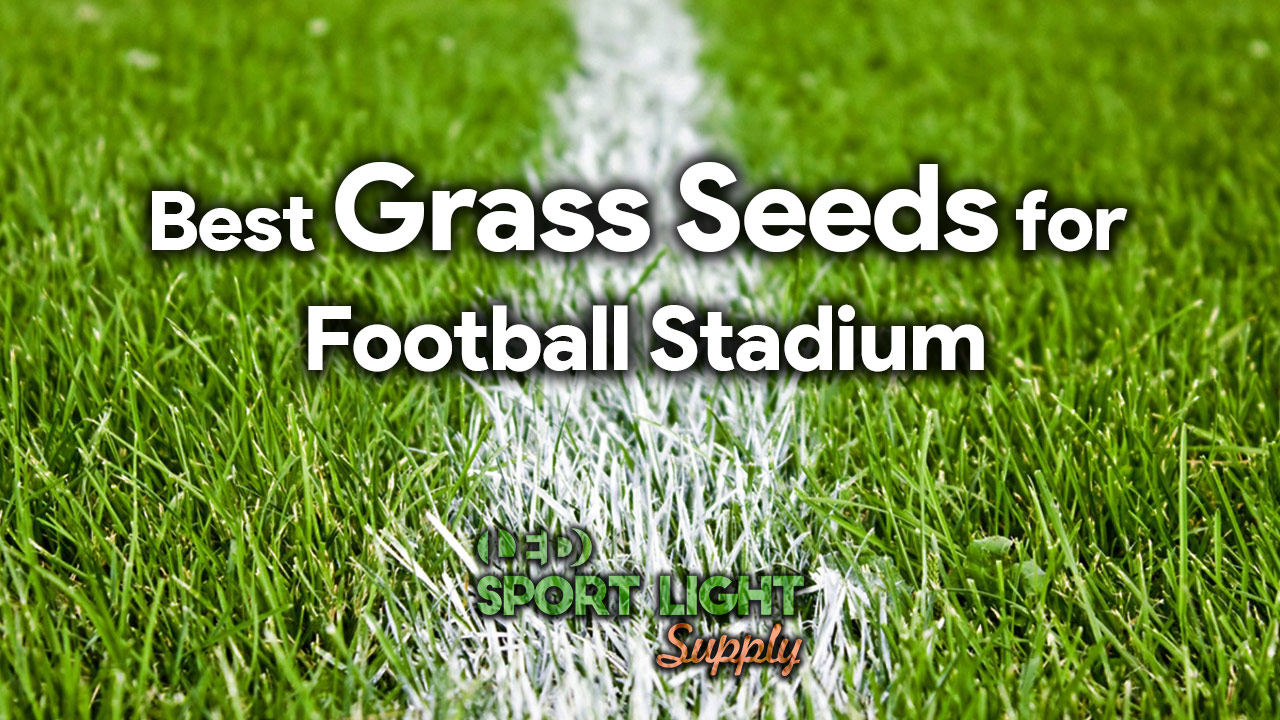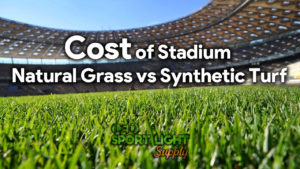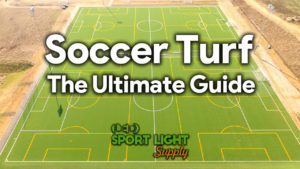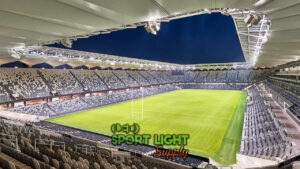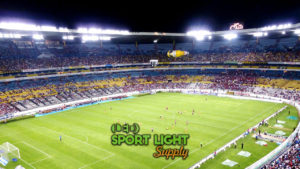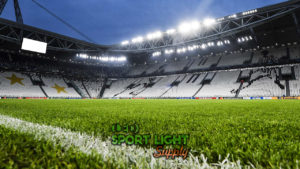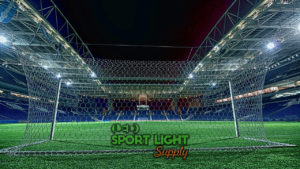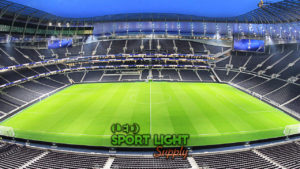Without suitable soil and seeds, managing a soccer or football field can be troublesome. The choice of the appropriate grass seed determines multiple factors. For example, wear resistance and drainage. In most cases, the Kentucky bluegrass is the popular first pick. At least, in the USA.
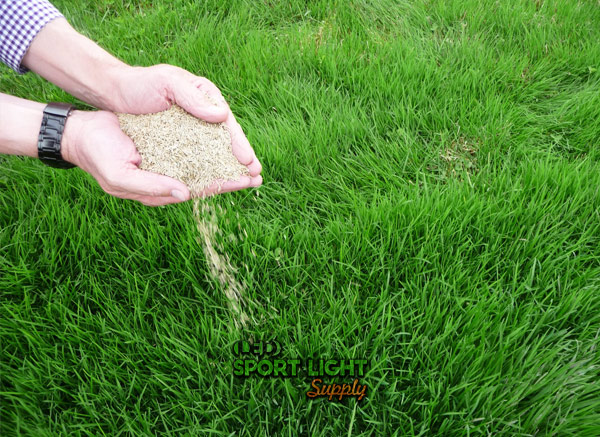 A blend of 65% Kentucky bluegrass and 35% ryegrass works well for soccer stadiums, too. Instead, you might want to switch to Tall fescue if your football stadium is in the South. Let’s see in more detail how you can select the best grass seed for your sports stadium.
A blend of 65% Kentucky bluegrass and 35% ryegrass works well for soccer stadiums, too. Instead, you might want to switch to Tall fescue if your football stadium is in the South. Let’s see in more detail how you can select the best grass seed for your sports stadium.
Before seeding a soccer field
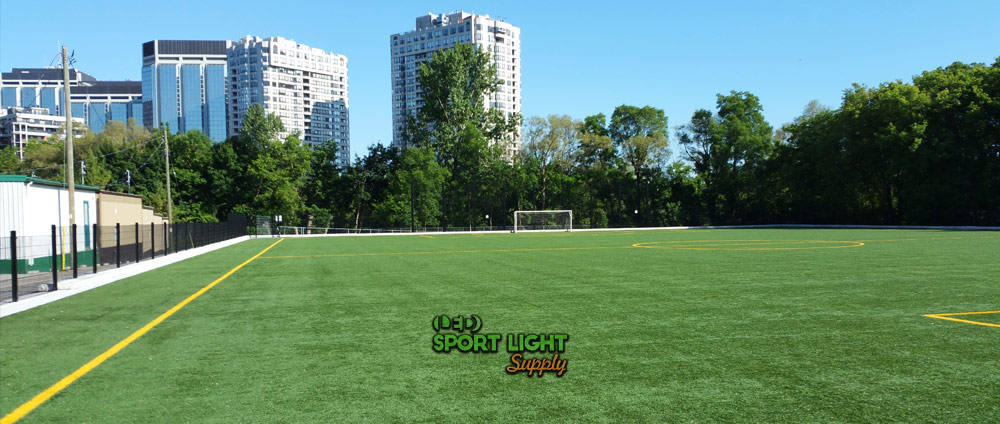
For the best results, you should pile high-quality soil across the playing area. Right off the bat, you should achieve a 2% slope from the imaginary center line to both sidelines. To specify, I mean the imaginary line that runs from goal to goal.
Perfectly flat soccer fields cannot provide proper surface drainage. Plus, they will get flooded. Which means more maintenance costs and interrupted matches.
Transforming a soccer field with lush grass can take up to five weeks. So, remember to consider any construction time to start seeding the soccer field by mid-August.
Select the grass seed variety while you wait for the soil to settle before the final grading. Also, take care of any deficiencies in nutrients by performing a soil test. By now, you should have gathered any information about the hours of sun per day in the playing area. Besides, the geographical location may influence the choice of certain species.
Selecting the best grass seed for soccer fields
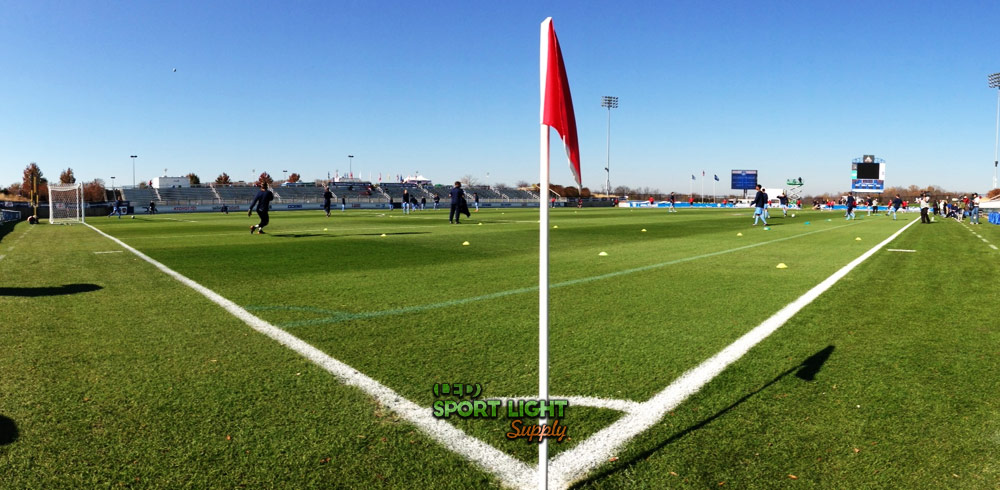
A resilient, natural turf made of Kentucky bluegrass and/or ryegrass may be your best option. Of course, you might want to adjust the species or variety selection over time. Mostly to avoid weeds and bare spots.
By going organic, you do not affect playability. But usually, natural grass makes playing soccer better.
Pitch aeration and fertilization play a critical role in maintaining optimal conditions. As a result, a strong turf outcompetes the annual weeds. You should aerate the pitch three to four times a year.
1. Which grass seed works best in the North?
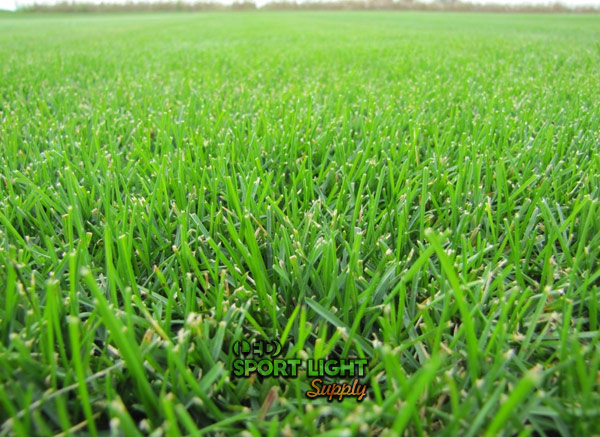 In the Northern United States, you should opt for a Kentucky Bluegrass seed or a Tall Fescue variety. Especially if you live in the colder areas of the country.
In the Northern United States, you should opt for a Kentucky Bluegrass seed or a Tall Fescue variety. Especially if you live in the colder areas of the country.
Clearly, you should choose a turf Kentucky or Fescue variety. In fact, some varieties are just bunch-type grasses. As the season progresses, you might notice color differences. So, you can refine the selection over the years to find the perfect variety.
Other factors include the blade width and texture of the grass. Some varieties have narrow leaf blades, while others might become too wide for the climate in your area. For example, the variety Midnight Kentucky Bluegrass has a smoother blade grass. Which really feels silky smooth and gives a more pleasing aesthetic look to the field.
2. Which grass variety works best in warm-weather US states?
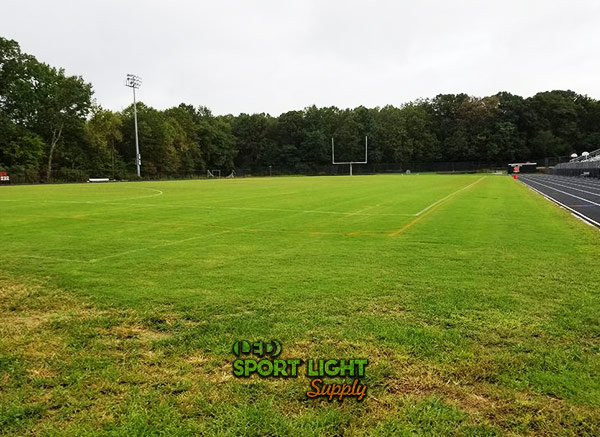 Bermuda grass is a though grass seed species that resist any sort of damage. If you do bit water it by mistake, it may get a pale color. But as soon as you start watering it again, it gets back to being a nice luscious green color. In short, it is the most drought-tolerant grass for dry summer days.
Bermuda grass is a though grass seed species that resist any sort of damage. If you do bit water it by mistake, it may get a pale color. But as soon as you start watering it again, it gets back to being a nice luscious green color. In short, it is the most drought-tolerant grass for dry summer days.
In detail, Bermuda grass does not require as much water as many other species. Mainly because the size of the leaf blade is quite small in comparison. During the day, wider leaf blades perspire most of their moisture. But the thin Bermuda grass leaves will just fold up when they are getting drought or heat stressed.
Bermuda grass is a rhizomatic and stoloniferous plant. So, it can go underground through rhizomes and above ground with stolons. In the end, you get a real low Bermuda lawn that looks fantastic and can handle the heat a lot better than other varieties.
The only thing to remember when planting Bermuda grass is that they love nitrogen. Especially during the hot months. So, you might need to hit the soccer field with some pounds of nitrogen per week in July.
You should get the Bermuda grass as thick as possible before winter after you seed it. Because the first season is critical to ensure a long-lasting organic turf. Usually, you do not even need to overseed the pitch with ryegrass.
Why choose one of the previous blends or species for playing soccer?
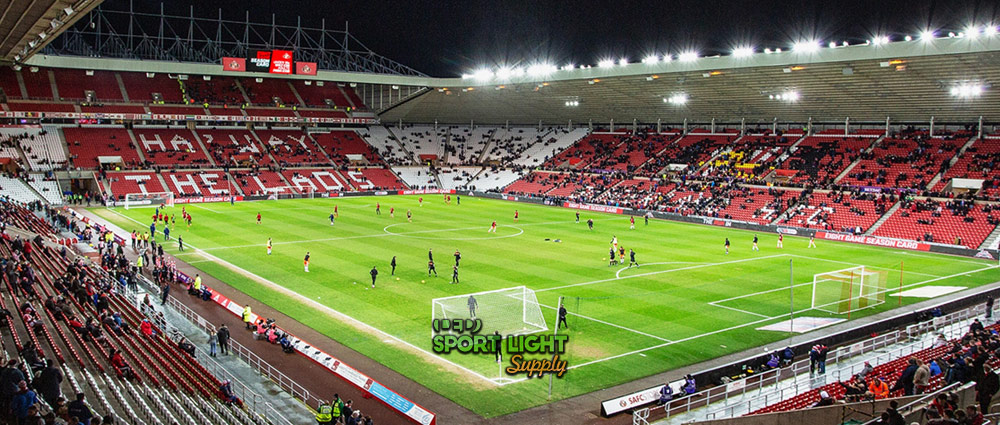
Soccer stadiums around the world still choose natural grass because it is ideal for this sport. On average, the soccer grass lasts from six months to several years.
Professional grass seed species and blends are resistant to heavy loads. This sought-after quality is necessary because soccer is a creative sport. So, players are always coming up with fast-paced strategies and tactics. Just think of counter-attack and counter-pressing. The goalkeeper leaps into the air and lands on the grass in the penalty area. This is also where most of the players gather during a corner kick. So, reducing wear and tear is imperative.
Natural grass provides shock absorption and ensures an optimal balance of stiffness and elasticity. Broadly speaking, high-quality natural grass helps to prevent injuries. Plus, it allows for a cooler playing area than artificial turf.
What other type of grass could you use in a soccer stadium?
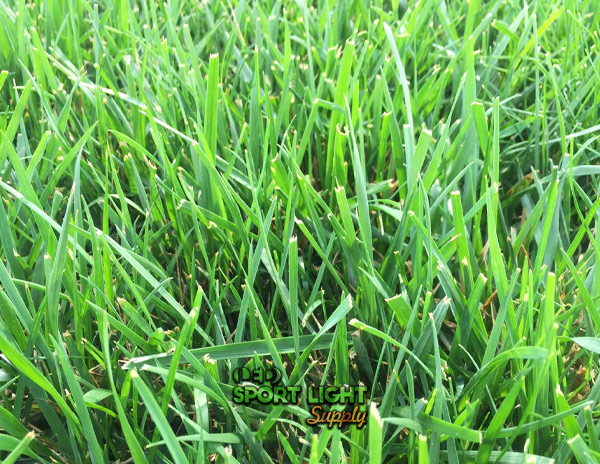 Tall Fescue is a popular choice for transitional zones. Especially if you cannot count on an overabundance of rain. As the name implies, Tall Fescue gets taller than other types of grass. Besides, it remains pretty green in warm conditions. Plus, this species can go on for two weeks without being watered.
Tall Fescue is a popular choice for transitional zones. Especially if you cannot count on an overabundance of rain. As the name implies, Tall Fescue gets taller than other types of grass. Besides, it remains pretty green in warm conditions. Plus, this species can go on for two weeks without being watered.
What you might not like about Tall Fescue is its tendency to clump into little spots instead of spreading evenly over the playing area. For this reason, it does not mix very well with other species like Bluegrass.
I would not recommend using Tall Fescue grass seeds in most Major League Soccer stadiums. But you could overseed the pitch with this grass seed species if it does not look thick enough. Of course, it is a great choice for any other soccer stadium.
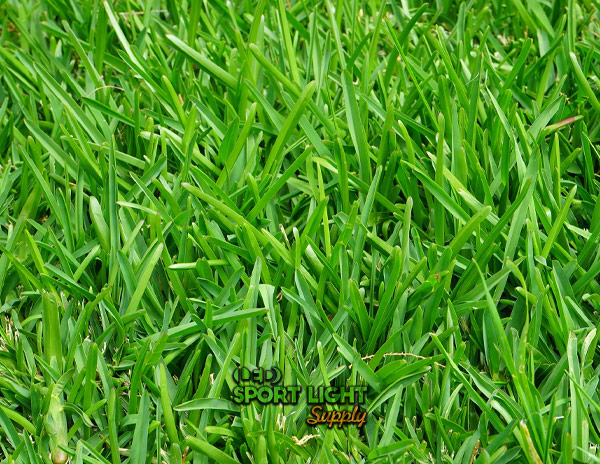 Perennial ryegrass is another great choice if you like cutting the grass real short. Usually, you can cut it to 20 mm, and it looks stunning. On the negative side, it grows back quick. So, you will need to cut it regularly each week.
Perennial ryegrass is another great choice if you like cutting the grass real short. Usually, you can cut it to 20 mm, and it looks stunning. On the negative side, it grows back quick. So, you will need to cut it regularly each week.
Before seeding a football field
Make sure to employ the best seeding strategies for managing the sports field. For this reason, use heavy equipment to compact the soil. In American football, both offense and defense go rough at each other. Whenever you see a backward pass or a lateral, the ball carrier stomps hard on the field. So, compaction issues can lead to both injuries and inaccuracy.
Before you select a grass seed that tolerates wear and tear, till the football arena with high-quality manure. Then, make a soil test to later amend it with the necessary nutrients. Usually, you would need to:
- take a soil sample
- send the sample off to a lab
- receive the analysis
Some soil sample test kits may be helpful for making your own testing as well. Especially to figure out what you need to add to your soil as the seasons pass by. Similarly, regular overseeding and aeration can reduce the chances of unrepairable damage. So, make sure to prepare a schedule according to the different grass seeds that you use.
Selecting the best grass seeds for playing football
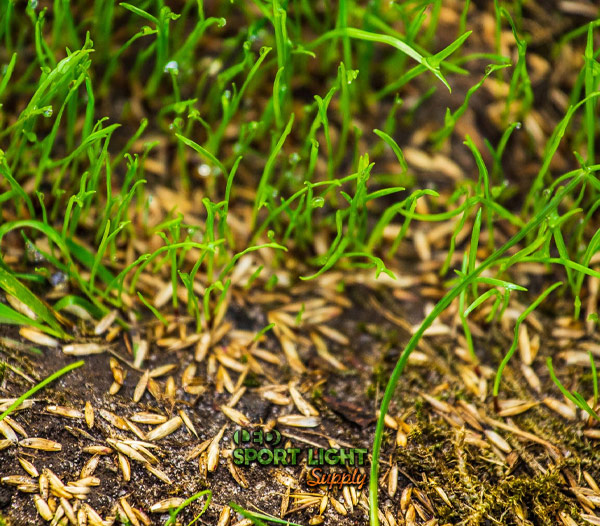 A blend of 80% Kentucky bluegrass and 20% perennial ryegrass works great in the football stadium. Mainly because they give you the most pleasing look to the football field. However, make sure you see the sod tag on the grass seed bag you want to buy. After all, you need no weeds in your stadium.
A blend of 80% Kentucky bluegrass and 20% perennial ryegrass works great in the football stadium. Mainly because they give you the most pleasing look to the football field. However, make sure you see the sod tag on the grass seed bag you want to buy. After all, you need no weeds in your stadium.
To clarify, Sod Quality means the manufacturer broke the seeds down to a fine section to check for weeds. You may read the label to find out the percentage of pure seeds along with the germination percentage. Most Kentucky bluegrass seeds have a germination percentage of 85% or more.
You can mow both Kentucky bluegrass and ryegrass low. But you might have to rake some hard spots to bury the seed a little bit and put some soil on top of them. Especially if you are seeding in the warm season.
If you are using a blend, consider adding some granular humic acid at the end. Humic substances improve the soil ecology. But their primary benefit for anyone looking over the football field is that they chelate nutrients. In brief, humic acid helps the roots of the grass to absorb vital micronutrients better than any other compounds in fertilizers.
Is Bermuda grass suitable for NFL field painting?
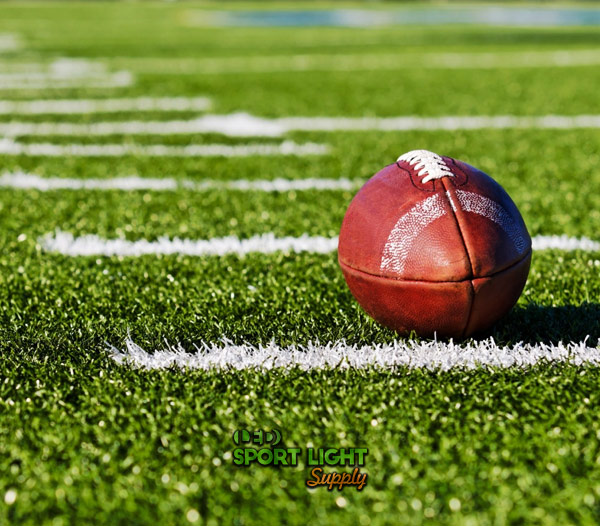 As Bermuda grass grows fast, you might want to spray the logo days before the game or event. In many NFL stadiums, however, a mix of artificial and natural grass may coexist. So, you could end up not having to worry about NFL painting issues at all.
As Bermuda grass grows fast, you might want to spray the logo days before the game or event. In many NFL stadiums, however, a mix of artificial and natural grass may coexist. So, you could end up not having to worry about NFL painting issues at all.
More importantly, the natural grass has to be the right mix for top athletes. So, you can use Bermuda grass as long as it provides the best conditions for play. The field surface must be comfortable, safe, and allow for a good footing. If the football ground is too hard, then it is abrasive and detrimental to the athletes. Instead, if it is too soft, it is tiring to run on it.
Bermuda grass can help you get a gorgeous thick green field. But you need to plan ahead. Month by month, you should be doing several maintenance actions to keep this type of grass in top shape. For example, you need to scalp the field and take it down low before summer. Possibly, in April. In this way, you can aerate early and keep it green for longer.
During spring and early summer, you should use a suitable fertilizer. But you can use general feeding with a 4-1-2 NPK ratio as well. By doing this, you will stop weeds and diseases that may kill your football field.
Here is a list of NFL stadiums that use Bermuda grass:
- Allegiant Stadium
- Arrowhead Stadium
- FedExField
- Levi’s Stadium
- M&T Bank Stadium
- Nissan Stadium
- Raymond James Stadium
- State Farm Stadium
- TIAA Bank Field
When should you use perennial ryegrass in a football stadium?
Perennial ryegrass is useful whenever you need rapid covers. Generally, the rye grass seed germinates within 47 days. So, you can mix in the bare spots on the field to restore the mowing quality.
Because ryegrass gets a lot of diseases, it is not a type of grass suitable to cover the whole football pitch. Plus, you should plant it only in areas that are at least 500 feet above sea level.
You can use ryegrass to oversee both Bermuda grass and Kentucky bluegrass to recover from traffic and wear and tear. After a while, the ryegrass tends to disappear. So, make sure to reseed the field when the sports season is over.
Is natural grass better than artificial turf for playing football?
The short answer is yes. Over time, artificial turf has led to injuries and other issues. Under the pretense of needing less maintenance, artificial turf got popular. But soon, the players themselves requested a less abrasive field. In short, real football deserves real grass.
Of course, natural grass requires careful planning. After all, you need to mow it every week or two. Then, you need to keep up with the maintenance calendar to avoid pitch freezing in winter. But if you maintain regular watering and fertilization, the grass will take care of itself most of the time.
Keeping athletic fields green depends on traffic tolerance. In the South, Bermuda grass is pretty much the industry standard for athletic fields. So, you would just traffic the plots with a traffic simulator for research purposes. That is, if you want to test a different grass seed for your football stadium.
Two passes per week are equivalent to the amount of stress that is produced by one NFL football game between the hash marks and the 40-yard line. On top of that, you should consider how many games per week the stadium host. Mainly because they affect the application of nitrogen to keep it green.

